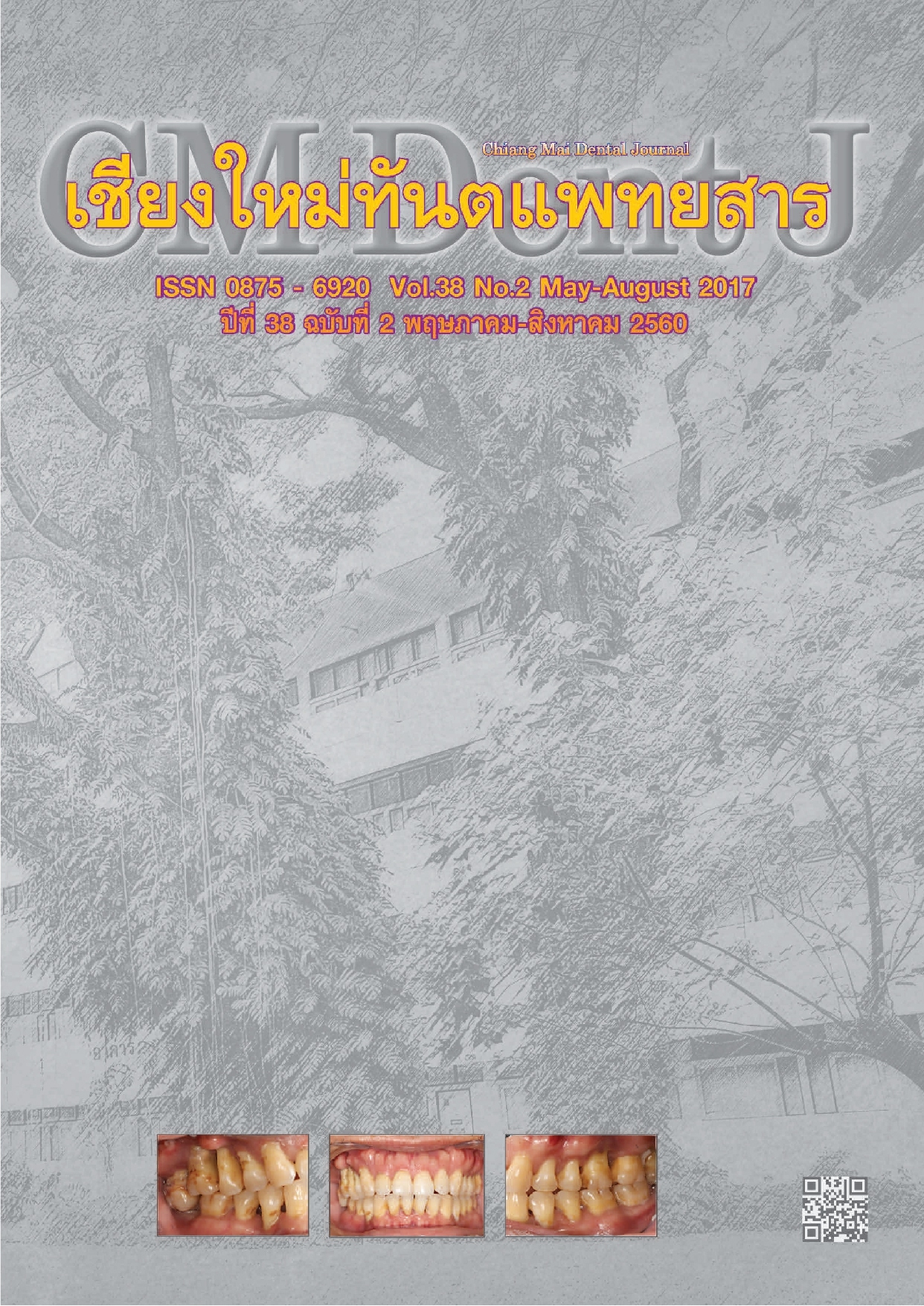Effect of Silanized Nano-Silica on Flexural Properties and Color Stability of Polymethyl Methacrylate
Main Article Content
Abstract
Objective: To investigate the effect of silanized nano-silica on flexural properties and color stability of polymethyl methacrylate (PMMA)
Materials and methods: Flexural properties were tested by 3-point bending on silanized nano-silica-reinforced PMMA bar (10±0.2 X 64±0.01 X 3.3±0.2 millimeters). There were 4 groups of nano-silica containing at 0, 1, 3 and 5 percentages by weight (wt %) of PMMA (n=10 for each group). Color differences of clear and tooth-colored PMMA specimens (11 ±0.2 X11 ±0.2 X2 ±0.2 millimeters) with silanized nano-silica contents at 0, 1, 3 and 5 wt% (8 groups, n=10 for each group) were measured using Spectrophotometer and then calculated into NBS units (National Bureau of Standard) to indicate color stability.
Results: The statistically significant highest flexural strength was the group with silanized nano-silica at 1 wt%, and the statistically significant highest flexural modulus was the group with silanized nano-silica at 5wt%. The groups with silanized nano-siliica at 1 and 3 wt% of tooth-colored PMMA had color stability.
Conclusions: This study showed that reinforcement of PMMA with 1 wt% silanized nano-silica significantly improved the flexural properties. Tooth-colored PMMA had color stability when reinforced with 1 and 3 wt% silanized nano-silica.
Article Details
References
The glossary of prosthodontic terms. J Prosthet Dent 2005; 1: 46.
Souzaa FD, Panzeria H, Vieiraa MA. Impact and fracture resistance of an experimental acrylic polymer with elastomer in different proportions. Mat Res 2009; 12: 415-418.
Vallittu PK, Lassila VP, Lappalainen R. Transverse strength and fatigue of denture acrylic-glass fiber composite. Dent Mater 1994; 10: 116-121.
Çökeliler D, Erkut S, Zemek J, Biederman H, Mutlu M. Modification of glass fibers to improve reinforcement: a plasma polymerization technique. Dent mater 2007; 23: 335-342.
Jagger DC, Harrison A, Jandt KD. The reinforcement of dentures. J Oral Rehabil 1999; 26: 185-194.
Yazdanie N, Mahood M. Carbon fiber acrylic resin composite: an investigation of transverse strength. J Prosthet Dent 1985; 53: 543-547.
Berrong IM, Weed RM, Young JM. Fracture resistance of Kevlar-reinforced poly (methyl methacrylate) resin: a preliminary study. Int J Prosthodont 1990; 3: 391-395.
Aydin C, Yilmaz H, Caglar A. Effect of glass fiber reinforcement on the flexural strength of different denture base resins. Quintessence Int 2002; 33: 457-463.
Braden M, Davy KWM, Parker S, Ladizesky NH, Ward IM. Denture base poly (methyl methacrylate) reinforced with ultra-high modulus polyethylene fibres. Br Dent J 1988; 164: 109-113.
Morgan AB, Antonucci JM, Van Landingham MR, Harris RH, Kashiwagi T. Thermal and flammability properties of a silica-PMMA nanocomposite. Polym Mater Sci Eng 2000; 83: 57-58.
Jaidamrong J, Phankosol P. Flexural strength of modified acrylic resin tooth material. Rajamangala University of Technology Isan, The 23rd national graduate research conference proceeding; 2011: 202-206. (in Thai)
Friedrich K, Fakirov S, Zhang Z. Polymer composites: from nano-to macro-scale. 1sted. New York: Springer Science & Business Media; 2005: 47-48.
Yang F, Nelson GL. PMMA/silica nanocomposite studies: synthesis and properties. J Appl Polym Sci 2004; 91: 3844-3850.
Chaijareenont P, Takahashi H, Nishiyama N, Arksornnukit M. Effects of silane coupling agents and solutions of different polarity on PMMA bonding to alumina. Dent Mater J 2012; 31: 610-616.
Karabela MM, Sideridou ID. Effect of the structure of silane coupling agent on sorption characteristics of solvents by dental resin-nanocomposites. Dent Mater 2008; 24: 1631-1639.
Langer A, Michman J, Seifert I. Factors influencing satisfaction with complete dentures in geriatric patients. J Prosthet Dent 1961; 11: 1019-1031.
Tin-Oo MM, Saddki N, Hassan N. Factors influencing patient satisfaction with dental appearance and treatments they desire to improve aesthetics. BMC Oral Health 2011; 11:16.
Carlsson GE, Otterland A, Wennstrom A. Patient factors in appreciation of complete dentures. J Prosthet Dent 1967; 17: 322-328.
Hamza TA, Rosenstiel SF, El‐Hosary MM, Ibraheem RM. Fracture Resistance of Fiber‐Reinforced PMMA Interim Fixed Partial Dentures. J Prosthodont 2006; 15: 223-228.
Arkles B. Silane coupling agent chemistry. 1sted. Pennsylvania: Petrarch Systems; 1987: 59.
Nincharoen S, Prayadsab P, Arksornnukit M, Chaijareenont P. Effect of different alumina filler amounts reinforced into acrylic denture base on tensile bond strength between denture teeth and denture base. CM Dent J 2013; 34: 71-80.(in Thai)
BSI. Dentistry - base polymers - Part 1: Denture base polymers 2013 (reference number ISO 20795-1:2013). Switzerland, International Organization for Standardization; 2013.
Guang H, Hiroshi M, Ying Ai L, Sinshuke S, Taizo H. Influence of denture cleansers on the color stability of three types of denture base acrylic resin. J Prosthet Dent 2009; 101: 205-213.
Marcelo CG, Bruna CRZ, Daniela MdS, Mario ACS, Amalia M. Effect of intrinsic nanoparticle pigmentation on the color stability of denture base acrylic resins. J Prosthet Dent 2013; 110: 101-106.
Wirley GA, Valentim ARB, Murillo SP, Marcelo CG. Effect of polymerization methods and thermal cycling on color stability of acrylic resin denture teeth. J Prosthet Dent 2009; 102: 385-392.
Culler SR, Ishida H, Koenig JL. Structure of silane coupling agents adsorbed on silicon powder. J Colloid Interface Sci 1985; 106: 334-346.
Balos S, Pilic B, Markovic D, Pavlicevic J, Luzanin O. Poly (methyl-methacrylate) nanocomposites with low silica addition. J Prosthet Dent 2014; 111: 327-334.


